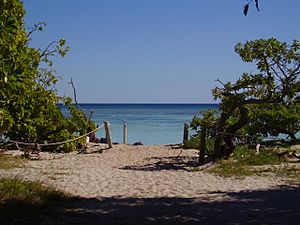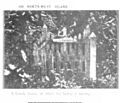North West Island facts for kids

North West Island shoreline
|
|
| Geography | |
|---|---|
| Location | Coral Sea |
| Archipelago | Capricorn Group |
| Total islands | 10 |
| Area | 1.05 km2 (0.41 sq mi) |
| Administration | |
|
Australia
|
|
| State | Queensland |
| Local Government Area | Gladstone Regional Council |
North West Island is a beautiful coral cay (which is a small, low island made of sand and coral) in the southern part of the Great Barrier Reef. It is about 75 kilometres northeast of Gladstone, Queensland, Australia.
North West Island is part of the Capricornia Cays National Park. It covers an area of 1.05 square kilometres, making it the second largest coral cay in the entire Great Barrier Reef. This island is also part of the Capricornia Cays Important Bird Area, which means it's a very special place for birds.
Contents
Island History: Past Uses and Protection
North West Island has an interesting past. In the 1890s, people mined guano here. Guano is a natural fertilizer made from the droppings of seabirds and bats. It was a valuable resource back then.
Later, from 1904 to 1914 and again from 1924 to 1926, factories called canneries operated on the island. These canneries processed turtle soup.
The importance of North West Island for its natural environment was officially recognized in 1980. That's when it became part of the Capricornia Cays National Park, helping to protect its unique wildlife and habitats.
The Island's Mysterious Grave
There is a grave located at the eastern end of North West Island. For many years, its origin has been a bit of a mystery.
Some stories from the early 1900s describe it as a baby's grave, kept very neat and tidy by loving hands. Other accounts from the 1920s suggest it might be the grave of a 17-year-old girl named L.L. Sundball. There was even talk that the name "Sundsvall" on the grave might refer to a city where the person came from.
Another story from 1928 mentioned the name L. L. A. Sundvall and the letters H.H. on a wooden cross. It suggested a hidden story of heroism or a battle against nature. Later in 1928, someone else claimed it was an infant's grave, and that an adult who died from a sea snake bite was also buried on the island.
In 1929, there was a reference to a grave with the letters T.J.G. cut into it. This was said to be the remains of a man named Tom Galviui or Galeon. The exact truth about who is buried there remains a part of the island's mystery.
Environmental Concerns: Oil Spill
In April 2010, there was a concern that oil from a ship accident might have reached North West Island. Small drops of oil were found along a beach. Cleanup crews quickly worked to remove the oil. Officials later thought the oil might have come from an earlier spill, not the recent ship accident. This event showed how important it is to protect the delicate environment of the Great Barrier Reef.
Island Life: Flora and Fauna
North West Island is a very important home for many plants and animals. The island's plant life is mostly made up of a dense Pisonia forest. Pisonia trees are known for their sticky seeds, which can sometimes trap birds.
Amazing Seabirds
The island is a crucial nesting ground for many seabirds. At times, as many as 500,000 seabirds can be found living on the island! It's an incredible sight.
A large number of wedge-tailed shearwaters, which are a type of seabird, nest here. In fact, 70 percent of all the wedge-tailed shearwaters that breed on Australia's east coast choose North West Island as their nesting spot.
You can also find the Capricorn silvereye on the island. This is a small bird that lives only in the southern Great Barrier Reef.
Sea Turtle Reproduction and Life Cycle
North West Island is also a vital place for turtles. Both the green sea turtle and the endangered loggerhead sea turtle come to the island to nest. They lay their eggs on the beaches between November and February each year.
Because these turtle nesting sites are so important, scientists carefully watch and count the nesting turtle populations every year. This helps them make sure these amazing creatures are protected for the future.
Images for kids



